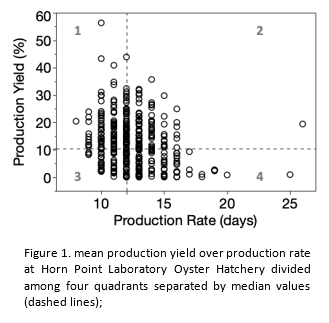SHELLFISH HATCHERY PRODUCTION ANALYSIS: A CASE STUDY AT HORN POINT LABORATORY OYSTER HATCHERY
Shellfish hatcheries have become an increasingly important component of aquaculture production in the United States. Although the industry has been advancing technologically over time to stabilize production and supply, detailed production analysis has rarely been reported. Understandably, commercial hatcheries may not want to openly share production deficiencies in order to preserve their reputation. Additionally, many commercial hatcheries may not keep copious amounts of records over time, which are necessary to track and analyze production trends.
To help fill the data gap and initiate a broader discussion on production trends, we report on long-term production trends (2011-2020) at Horn Point Laboratory's oyster hatchery, which included persistent production failure during the 2019 season. During the 2019 season, larval assays were conducted to determine drivers of production failure; however, no clear culprits were identified. Production metrics of interest where production yield (millions eyed-larvae produced) and production rate (days to reach the eyed larval stage). A variety of factors stretching across the entire production process (i.e. broodstock selection, conditioning, spawning, larval culture) were considered as possible predictors of production metrics. Furthermore, water quality in the Choptank River, the source of water for the hatchery, were used as input during analysis. Machine learning was used to train models of production yield (R2 = 0.54) and hindcast the specific conditions when the hatchery's production was most efficient.
We identified several important factors that predicted production yield and production rate. Many of these factors the hatchery staff can manipulate or represent a stage in the production process, which improved, could lead to greater production efficiency. Collectively, we conclude that more research, data sharing, and cross-institution collaboration are needed to understand production variability within and among shellfish hatcheries to maintain high levels of consistent shellfish aquaculture production.
